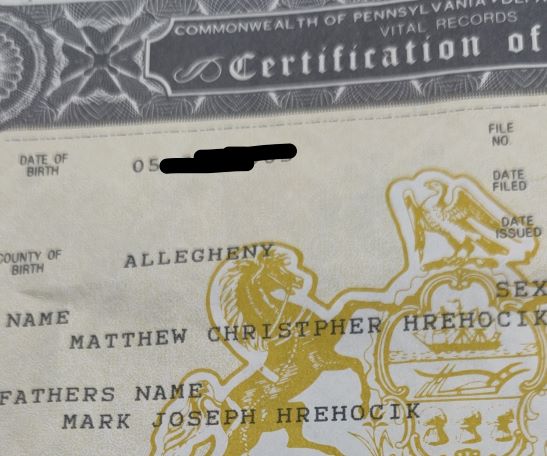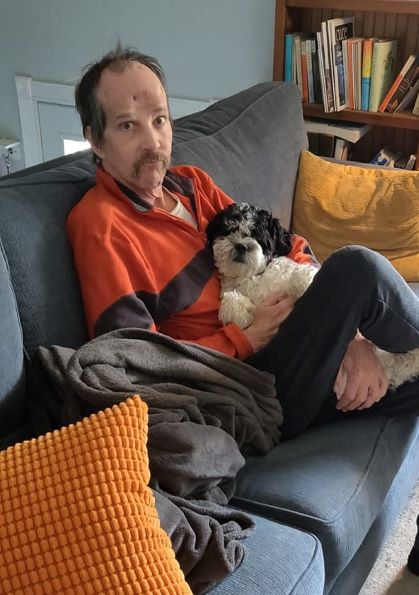This is not cancer.
I just want to make that clear, because someone asked. This is the aftermath of cancer and cancer treatment. Mark is currently stamped the glorious NED (No Evidence of Disease). The aftermath of cancer without treatment would have been no Mark. Instead, we have Mark and a lot of chronic problems. And acute problems. We have problems.
On Friday, we drove the well-worn path back down to Presby and met with Mark’s newest ENT surgeon. While we waited together in the exam room, I said something positive, like, “This is the best doctor’s office! They are always on time!” Mark looked at me with a rare look. One of fatigue. At me. I gave it a guess. “Do you get tired of me being positive all the time?” “Occasionally,” he said. “Should I try to be more pessimistic?” I said, perkily. “Yes,” he said.
We were quiet for a while.
“Am I allowed to be fake-pessimistic about things?” No, he said, I can only be genuinely pessimistic. “That’s going to be hard for me,” I said.
The PA came in and shot numbing agents up Mark’s nose. This was to get Mark ready to be scoped, which is an extremely uncomfortable procedure that he literally never complains about. She checked his ears and left.
“You could complain more,” I said. “You never complain.”
Above his mask, Mark’s eyes lit up a smidge.
“No!” he said. “I refuse!”
“I bet you can’t!” I retorted.
We both laughed. Then we went back to quietly waiting.
The surgeon came in and introduced himself. “Who do we have here?” he asked Mark, pointing to me. I wondered if this was a quick cognitive check. Which would be fair, I am constantly giving Mark little cognitive tests. Yet I also have come to learn that any one data point is pretty meaningless. In that moment, Mark could say who I am to him. Also, though, a few minutes earlier, Mark had turned to me and said, “I wonder why they shot something up my nose but then looked in my ears.” On a scale of 1-10 for that remark’s indication of his cognition, in that moment, I’d give him a 3.
The surgeon palpated Mark’s head like he was shopping for a melon at the grocery store. He felt Mark’s forehead, temples and cheeks. He pressed on Mark’s forearms and watched the blood move. He had Mark drop his pants and felt his thighs.
The short of it: the surgery likely will include taking tissue and muscle from Mark’s thigh, as well as veins and arteries from his forearms, in order to fill in Mark’s no-skull “dead space” with living tissue. “We’re going to pack it,” Dr. S said, “because there’s always a chance that the tissue will separate again. He’ll have a lump on his forehead, but it will likely go down.”
I nodded. Okay. Nothing like being told during the surgical consult that the surgery may not work. Or that your upcoming trauma will be a visual reverse of the previous post-surgical trauma of seeing the skin sag between Mark’s eyebrows and his brain pulsing beneath.
“So Mark,” I said loudly and probably a little too brightly for Mark’s mood, “You’re going to go from having a valley to a mountain.”
Yes, the surgeon concurred.
“It will be a cranial approach,” he continued. Ten minutes into the appointment, I already was beginning to go down the sinkhole of mental overload. An ear to ear, incision. Again. “I think in Mark’s case, I will not be able to connect the blood vessels into his cheek, so I will need to drape them down and connect them into his neck.”
This took me a minute to process. I pictured exactly what the surgeon said. Blood vessels draped down Mark’s face. Inside, I mentally corrected myself. INSIDE his face. How do you get blood vessels from a forehead to a neck, I thought? Remove his whole face and then stick it back on?
“I’ll try to save his forehead skin, but if not, I’ll replace it with thigh skin. “
I pictured that. Hairy man-thigh-skin stuck to Mark’s forehead.
I noticed I was listing in my chair. I straightened up. I turned my focus to Mark. How was he receiving this? “Is there anything else you wanted to ask, Mark?” He looked at me blankly. “Did you want to ask when the surgery would be?” I prompted. Mark faced the surgeon. ‘When will the surgery be?” he asked.
That part remains unclear. Dr. S is deferring to Mark’s other ENT surgeon and the neurosurgeon to decide the immediacy. “Getting three surgeons together is like herding cats,” Dr. S laughed. Within a month or two, he thought possibly. Or if Mark’s skin starts to deteriorate faster, sooner.
On the drive home, snippets of Dr. S’s sentences and the images they conjured clicked through my mind like slides on a Viewmaster. Five percent chance of blood clots. A week of inpatient monitoring. Drains. Sutures. All the stuff.
ALL THE STUFF.
When we got home, Mark laid down to nap. I called my parents to explain the situation. I had a moment. “WHO DOES THIS? Harvests and drapes veins? Psychopaths? Serial killers?”
Surgeons. Surgeons do this. And I’m grateful. And freaked out. Reasonably.
“There shouldn’t be impact on his brain from this surgery,” the neurosurgeon explained to me last week, “because we won’t be cutting into his skull.” Okay, sure. Per Mark’s request, I am willing to be pessimistic about this. I think his brain may react. Based on experience, I think that’s fair to assume.
“How did the doctor appointment go, Dad?” Michael asked later. “They’re going to attach tissue to my forehead to cover this red spot so it doesn’t get infected,” Mark responded. Michael glanced over to me for confirmation. I shook my head, yes, close enough. “Is that a big surgery?” Michael asked Mark. “Oh, it doesn’t seem like they think it will be too hard,” Mark said. Michael glanced at me. No, I shook my head.
On Saturday, I forced myself to have some me-time. I spent a couple hours with my friend Hilary. I fought a feeling of guilt, knowing that by leaving Mark home with the boys, I was negotiating some balance between my own wellbeing and Mark’s, which of course are intertwined. But I knew I needed more spoons, to use a concept Alma taught me. A “spoon” is like a mental unit representing your capacity to cope with what life is throwing at you in the moment. As I was listing in the surgeon’s office, I had thought, dang, this is going to take a LOT of my spoons. The way to get more spoons is to do some darn good self-care, whatever that looks like for you.
Driving to Hilary’s, I thought, Mark’s going to have some bad crap happen soon. I need a big dollop of love and friendship and sunlight and laughter. If ever there was a need for me to build a bunker of emotional resources, it’s now. Because whatever is ahead, it’s gonna be rough.





